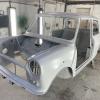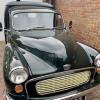Best phone Newman and ask them, I came across it while looking for a camshaft manufacturer to modify an existing set of camshafts for an on going project.Is that for flat tappet knock in? Everything I've read from large brands, including most state side for v8s, all mention correctly knocking the cam in to allow micro profiling of the lobe vs follower surface.Starting the Engine:-
Remove the spark plugs, turn the engine over on the starter motor until the oil light goes out/or the oil pressure registers pressure. Replace spark plugs.
Start the engine as you would in normal use. There is no need to run the engine at 3000 RPM for 20 minutes. Just treat the engine as if it was new for the 100 miles then off you go.
To obtain maximum performance on PH3/4/5 cams a visit down to the rolling road is advisable.
Just to throw a spanner in the works, the above is straight off of a well known camshaft manufacturer's website, enjoy.
Shooter
Shooter
Just rang them, they said for flat tappet cams run at 2.5k for 30 minutes.



















